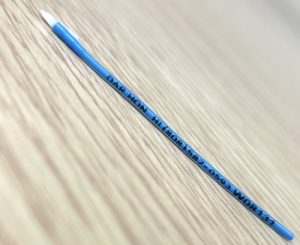9/18/25 – Shoreline fish sampling in Waikiki

DAR biologist and fisherman, Neal Hazama casting a net.
The Art of Casting
The midmorning sun already sits high in the sky, its rays piercing the shallow waters of Waikiki. The fisherman moves steadily through the cool, waist-high waves as they lap gently against him, his throw net segmented into thirds and ready for launch. Several yards ahead, his quarry– a school of weke(goatfish), stirs anxiously beneath a pier. They are familiar with this scenario and the danger it presents, but they are not yet ready to risk potential predators awaiting them in deeper waters. “The shade helps them feel safe.” explains fisherman Neal Hazama. With decades of experience guiding his movements, Neal gauges the remaining distance, braces against the wind, and throws! The net blossoms like a flower in mid-air before splashing down in a near-perfect circle over the heart of the school, its weights quickly bringing it to the bottom. Success! Over two dozen of the goatfish have been ensnared, and Neal begins to haul his catch to shore. These fish are not destined for the dinner plate however. Instead, they have the honor of contributing to over 25 years of scientific data, before being released back where they were caught.
The Process of Processing
Every month Neal conducts a shoreline sampling survey of Waikiki with his thrownet, starting from Kaisers and ending all the way at the Diamond Head lighthouse. The purpose of this ongoing study helps to assess not only the biodiversity of Oahu’s nearshore waters, but the species density as well. Often, Neal is able to identify the species, number, and size range of the fish by sight alone, but it is when he lets his net fly, that things really get interesting.

Neal Hazama measures a fish while biologist Bryan Ishida records the data.
As Neal approaches the beach, I hurry to fill a five gallon bucket with seawater and haul it to dry land. A portable air pump is added to maintain oxygen levels and as the fish are dropped in, I produce a measuring shoot and tagging kit from our dive bag. With practiced efficiency, Neal measures the length of the fish from snout to tail fork, while I record the data. Then, a plastic tag with an identification number and phone number is imbedded just under the animal’s skin before we release it out to sea once more.

A closeup of a DAR plastic fish tag. If a fish is caught, please call the number listed (808.587.0593)
If you or anyone you know catches this fish in the future, feel free to keep your catch, but we appreciate it if you contact the included phone number to report it (808.587.0593), the tag can help DAR identify the individual and compare how much it has grown and how far it has travelled since its original capture. The over two decades’ worth of cumulative data from these catching and tagging studies is critical in influencing some of the regulations put in place with regards to fish bag limits and catch sizes. It isn’t only weke, either. Moi(thread fin) are also tagged, but visual confirmation still provides valuable data on all species, especially those valuable to fishermen, such as aholehole(flag tail), ʻōʻio(bonefish), and kala(unicorn fish).
Cultivating Community

A tagged weke is ready for release.
Neal’s work seldom goes unnoticed by the public and we are frequently engaged by visitors and locals alike, providing a prime opportunity to engage with them in an impromptu information and education session. Some especially enthusiastic and lucky keiki are even permitted to help with the fish release as a way to encourage their burgeoning interests in fishing and marine biology. There are many more watermen and lifeguards who already recognize Neal and don’t hesitate to great him with a smile and a wave of aloha.
Neal always returns the smile, “After doing this some 25 years, you start to remember people.”
At the same time, Neal is always considerate to give space to others using the sea, such as kids bodyboarding, nearshore fishermen, and even monk seals sleeping on the beach. As important as this study is, the ocean is a shared space and it is important to maintain good relationships. Perhaps equally valuable to the data gathered from this shoreline sampling are the lessons it imparts: to live with aloha.
by Charles Lee
DAR Education Specialist of Oahu
